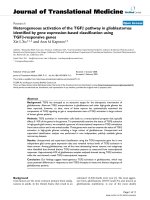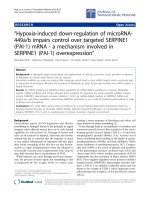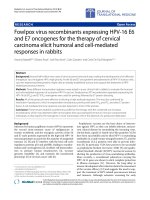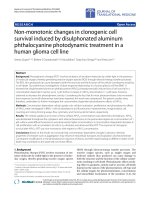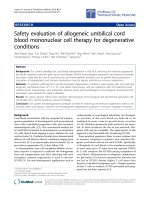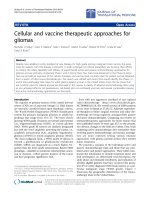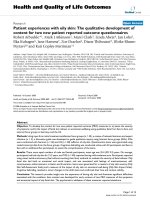Báo cáo hóa học: " Gait training with partial body weight support during overground walking for individuals with chronic stroke: a pilot study" ppt
Bạn đang xem bản rút gọn của tài liệu. Xem và tải ngay bản đầy đủ của tài liệu tại đây (1.2 MB, 8 trang )
JNER
JOURNAL OF NEUROENGINEERING
AND REHABILITATION
Gait training with partial body weight support
during overground walking for individuals with
chronic stroke: a pilot study
Sousa et al.
Sousa et al. Journal of NeuroEngineering and Rehabilitation 2011, 8:48
(24 August 2011)
RESEARCH Open Access
Gait training with partial body weight support
during overground walking for individuals with
chronic stroke: a pilot study
Catarina O Sousa
1
, José A Barela
2,3
, Christiane L Prado-Medeiros
1
, Tania F Salvini
1
and Ana MF Barela
3*
Abstract
Background: It is not yet established if the use of body weight support (BWS) systems for gait training is effective
per se or if it is the combination of BWS and treadmill that improves the locomotion of individuals with gait
impairment. This study investigated the effects of gait training on ground level with partial BWS in individuals with
stroke during overground walking with no BWS.
Methods: Twelve individuals with chronic stroke (53.17 ± 7.52 years old) participated of a gait training program
with BWS during overground walking, and were evaluated before and after the gait training period. In both
evaluations, individuals were videotaped walking at a self-selected comfortable speed with no BWS. Measurements
were obtained for mean walking speed, step length, stride length and speed, toe-clearance, durations of total
double stance and single-limb support, and minimum and maximum foot, shank, thigh, and trunk segmental
angles.
Results: After gait training, individuals walked faster, with symmetrical steps, longer and faster strides, and
increased toe-clearance. Also, they displayed increased rotation of foot, shank, thigh, and trunk segmental angles
on both sides of the body. However, the duration of single-limb support remained asymmetrical between each
side of the body after gait training.
Conclusions: Gait training individuals with chronic stroke with BWS during overground walking improved walking
in terms of temporal-spatial parameters and segmental angles. This training strategy might be adopted as a safe,
specific and promising strategy for gait rehabilitation after stroke.
Background
Typically, indiv iduals with stroke walk slower than t heir
peers and present asymmetry in spatial-temporal para-
meters [1,2] and joint angles [3]. These typical charac-
teristics may influence the return of pre-stroke
conditions [4], mainly because there exists an increased
risk of falli ng [5], followed by decreases in autonomy,
and consequently, an increase in social isolation [6,7].
Therefore, reestablishing independenc e via walking is a
crucial goal of any rehabilitation program for individuals
with stroke [3,4,8].
Among the different strategies of gait training for indi-
viduals with stroke, the use of a partial body weight sup-
port (BWS) system has continued to gain popularity
[9-13]. This strategy of gait training originated from
experiments on animals with complete spinal cord
transections [14,15], which established that training on a
treadmill promotes the generation of an automatic loco-
motor pattern b y spinal neurons [16,17], named the
central pattern generator. Gait training humans affected
by stroke using a BWS system on a treadmill increased
walking speed and endurance when compared to con-
ventional gait training overground [9] or when using
only a treadmill [10].
A BWS system alleviates the body weight of the lower
limbs symmetrically [10,18,19], promotes stabilization of
the trunk [20], improves balance control, and avoids
falls [16]. Most studies had adopted 30% of a subject’s
* Correspondence:
3
Graduate Program in Human Movement Sciences, Institute of Physical
Activity and Sport Sciences, Cruzeiro do Sul University, São Paulo, SP, Rua
Galvão Bueno, 868, 13° andar, Bloco B, 01506-000, São Paulo, SP, Brazil
Full list of author information is available at the end of the article
Sousa et al. Journal of NeuroEngineering and Rehabilitation 2011, 8:48
/>JNER
JOURNAL OF NEUROENGINEERING
AND REHABILITATION
© 2011 Sousa et al; licensee BioMed Central Ltd. This is an Open Access article distributed under the terms of the Creative Commons
Attribution License ( which permits unrestricted use, distribution, and reproduction in
any medium, provided the original work is properly cited.
body weight unloading due to this percentage’s effective-
ness on gait training [9,12,21,22]. Additionally, the type
of training surfaces used by patients is crucial, and this
consideration may facilitate skill transfer to daily life
activities [23,24]. To our knowledge, no one has evalu-
ated the effects of gait training with partial BWS during
overground walking on the walking performance of indi-
viduals with stroke. P revious studies concerni ng BWS
during overground walking investigated changes in gait
patterns but not its training effects [22,25-27]. There-
fore, the purpose of this study was t o investigate the
effects of gait training on ground level with partial BWS
on temporal-spatial parameters and on lower limb and
trunk segmental angles of individuals with chronic
stroke during overground walking without BWS. It was
hypothesized that these individuals’ gait performance
would improve after six weeks of the proposed gait
training and they would experience reduced asymmetry.
Methods
Participants
Twenty individuals with chronic stroke discharged from
a conventional rehabilitation program at a physical ther-
apy clinic at the university where this study took place
volunteered for t his study. After an initial evaluation,
which occurred one week before the initiation of g ait
training and consisted of personal data registration
(name, home address, telephone, birth date, time of
stroke, type of lesion, re ported neurological and ortho-
pedic diseases) and a physical examination (body mass,
stature, blood pressure, cardiac and respiratory fre-
quency, paretic body side, level of spasticity, body defor-
mities, functional gait capacity), sixteen individuals were
eligible to participate in this study, according to the
inclusion and exclusion criteria described in the
following paragraph. However, four of these individuals
did not complete the gait training program due to pre-
vious orthopedic complications (n = 3), not reported on
the time of the initial evaluation, or desistance (n = 1).
General information of the remaining twelve individuals
that completed all the stages of the study is presented
on Table 1.
Inclusion criteria were: an elapsed time longer than
one year since stroke and the ability to walk approxi-
mately 10 m with or without assistance. Participants
were excluded if: they presented any c linical signs of
heart failure (New York Heart Association), arrhythmia,
or angina pectoris; orthopedic (n = 2) or other neurolo-
gical diseases (n = 2) that compromised gait; or severe
cognitive or communication impairments. All indivi-
duals signed a n informed consent agreement approved
by the University ethics committee prior to participating
in this study in accordance with the Declaration of
Helsinki.
Training sessions
Individuals were supported by a horizontal bar equipped
with a harness with adjustable straps for the hips and
thighs [27], as they walked overground along a 10 m
walkway (Figure 1). A steel cable from an electric winch
adjusted the horizontal bar vertically and a load cell,
connecting the horizontal bar to the cable, measured
theamountofweightbornebytheBWSsystem,which
was shown on a digital display. Before walking, partici-
pants remained still when the winch was activated by
the experimenter until adjusting 30% of body weight
unloading. After the first three weeks, body weight
unloading was adjusted to 20%. Individuals’ body mas s
was measured weekly to ensure that the appropriate
percentage of body weight was unloaded.
Table 1 General information of the participants that completed all the stages of the study
Participant Gender Age (years) Mass (kg) Height (cm) Type of Lesion Hemiparesis Time of post-stroke (years)
1 M 43 69.8 172 Ischemic Right 8
2 M 64 72 177 Hemorrhagic Left 7
3 F 43 76.7 165 Ischemic Right 1
4 M 50 78.6 176 Ischemic Right 7
5 F 44 110 169 Ischemic Right 5
6 M 59 80.8 183 Ischemic Right 6
7 M 49 97.1 169 Ischemic Right 1
8 F 56 102.4 163 Ischemic Left 1
9 M 62 82.3 167 Ischemic Left 4
10 F 52 66.4 161 Hemorrhagic Left 6
11 M 55 102 175 Ischemic Left 1
12 M 61 91.4 163 Ischemic Left 10
Mean - 53.2 85.8 170 - - 4.6
SD - 7.5 14.4 6.7 - - 3.0
Note: M = male; F = female
Sousa et al. Journal of NeuroEngineering and Rehabilitation 2011, 8:48
/>Page 2 of 7
During training sessions, verbal cues that could
improve walking speed and joint excursion were given.
Heartrateandbloodpressurewereobservedatthe
beginning and end of each session and when individuals
reported any discomfort during the training session to
ensure their safety. Rest periods were allowed during
each training session according to individual needs.
All individuals were submitted to 45-minute gait train-
ing sessions wearing their w alking shoes, three times a
week, alternating days during six weeks. No participant
was given any other type of physical intervention or
conventional gait training, stretching, muscle strength-
ening or endurance exercises while participating in this
study.
Gait assessment
Individuals were assessed at least one day before the
first gait training session and at least one day after the
last gait training session (but no longer than one week
either before or after the gait training period), walking
freely at self-selected comfortable speeds along a 10 m
walkway six times. They were videotaped by four digital
cameras (AG-DVC7P, Panasonic) at 60 Hz, which were
positioned bilaterally allowing simultaneous kinematics
measurements of paretic and nonparetic limbs in either
direction of motion (from left to right and vice-versa).
During the evaluation, individuals w ere not allowed to
use any assistive devices, and when necessary, they
walked while holding the index finger of one of the phy-
sical therapists to assist their balance, without providin g
any meaningful mechanical support.
Passive reflective markers were placed on the non-
paretic and paretic sides of the body at the following
anatomical locations: head of the fifth metatarsal, lateral
malleolus, lateral epicondyle of the femur, greater tro-
chanter, and acromion, in order to define the foot,
shank, thigh, and trunk segments, respectively. The digi-
talization and the reconstruction of all mar kers were
performed using the Ariel Performance Analysis System
- APAS (Ariel Dynamics, Inc.) software. Filtering and
posterior analyses were performed using Matlab soft-
ware (MathWorks, Inc.). Reconstruction of the real
coordinates was performed using the direct linear trans-
formation (DLT) procedure.
Outcome measures
One intermediate stride (walking cycle) per trial by each
individual, for a total of three selected trials, was ana-
lyzed. The trial selection was determined by the best
visualization of the markers and walking performance in
an uninterrupted trial. Through visual inspection, a
stride was defined by two consecutive initial contacts of
the same limb to the ground along the progression line.
Additionally, walking events during a walking stride
were identified for subsequent calculation of temporal
organization of walking (initial and terminal double
stance, single-limb support, and swing period). This pro-
cedure was performed for both nonparetic and paretic
sides. All data were digitally filtered using a 4
th
order
low-pass and zero-lag Butterworth filter with a cutoff
frequency of 8 Hz, defined based upon residual anal ysis
[28].
The following variables were examined: mean walk-
ing speed, calculated as the ratio between the distance
traveled and its duration (determined by the position
of the greater trochanter marker, which is closer to
the center of body mass); step length, the distance
between initial contact of each foot; stride length, the
distance between two successive initial contacts of
each foot to the ground (determined by the position
of the lateral malleolus marker); stride speed, calcu-
lated as the ratio between stride length and duration;
duration of total double stance and single-limb sup-
port [29], vertical distance between foot and walking
surface during swing period - “toe-clearance” (deter-
mined by the difference between maximum and mini-
mum vertical position of the marker placed on the
fifth metatarsal), and maximum and minimum foot,
shank, thigh, and trunk segmental angles d uring each
stride. The conventions adopted to describe segmen-
tal rotations were counter-clockwise (backward) and
clockwise (forward) rotations around the medial-lat-
eral axis in the sagittal plane, which denoted positive
and negative values, respectively [30]. For example, a
counter-clockwise rotation of the trunk means trunk
extension from the neutral position and a clockwise
rotation means trunk flexion from the neutral
position.
Figure 1 Partial view of a gai t training session with the body
weight support system used in the study. The rail that the
electric motor slides along, the load cell, and one of the participants
of the study wearing the harness are shown.
Sousa et al. Journal of NeuroEngineering and Rehabilitation 2011, 8:48
/>Page 3 of 7
Statistical analysis
For all variables, data from thre e trials under each eva-
luation were averaged for each participant. A one-way
analysis of variance (ANOVA) was conducted, using
evaluation (before and after gait training) as a factor and
mean walking speed as the dependent variable. Two
two-way ANOVAs and six multivariate analyses of var-
iance (MANOVAs) were employed, using body side
(nonparetic and paretic) and evaluation as factors. The
dependent variables were step length and toe-clearance
for the two ANOVAs, and stride length and stride speed
for the first MANOVA; durations of total double stance
and single-limb support for the second MANOVA; and
minimum and maximum foot, shank, thigh, and trunk
segmental angles for the third, fourth, fifth, and sixth
MANOVAs, respectively. When applicable, univariate
analyses and the Tukey post-hoc t ests were employed.
An alpha level of 0.05 was adopted for all statistical
tests, which were performed using SPSS software.
Results
During evaluations, none of the individuals used assis-
tive devices. However, during the first evaluation (before
training) two participants needed assistance from a phy-
sical therapist, who offered her index finger, to assist
their balance when walking. During the second evalua-
tion (after training) only one participant needed the
same type of assistance when walking. All participants
expressed interest and motivation throughout the train-
ing period, and they disseminated their experiences with
the study to other nonparticipants with stroke.
Table 2 depicts the mean and standard deviation (±
SD) of gait cycle temporal-spatial parameters before and
after gait training for both sides of the body. Individuals
walked faster after gait t raining (F
1,11
= 8.384, p =
0.015). ANOVA revealed interaction between the sides
of the body and evaluation of step length (F
1,11
= 7.952,
p = 0.017). Post-hoc tests indicated that the ste p length
of the nonparetic side was longer than the step length
of the paretic side before gait training, and that after
gait training step length of the paretic side became simi-
lar to the step length of the nonparetic side.
Toe-clearance increased after trai ning (F
1,11
= 5.609, p
= 0.037), and the nonparetic side showed greater toe-
clearance than the paretic side, (F
1,11
= 7.092, p =
0.022). Stride length and speed were also influenced by
training (Wilks’ Lambda = 0.463, F
1,11
=5.789,p=
0.021), with univariate analyses indicating increased
stride length (F
1,11
= 12.040, p = 0. 005) and st ride speed
(F
1,11
= 7.010, p = 0.023) on both sides of the bod y after
gait training.
Regarding the stance period, MANOVA revealed only
a side of the body effect (Wilks’ Lambda = 0.085, F
1,11
=
54.028, p = 0.001). Univariate analysis indicated that the
nonparetic side showed a longer single-limb support
duration than the paretic side (F
1,11
=116.536,p=
0.001).
Table 3 depicts the mean (± SD) of minimum and
maximum foot, shank, thigh, and trunk segmental
angles during a gait cycle of both sides of the body
before and after gait training. MANOVA revealed a
training effect (Wilks’ Lambda = 0.461, F
1,11
= 5.856, p
= 0.021), and a side of the body effect (Wilks ’ Lambda =
0.216, F
1,11
= 18.184, p = 0.001) for minimum and maxi-
mum foot segmental angle. Univariate analysis indicated
that both counterclockwise (F
1,11
= 8.187, p = 0.015)
and clockwise foot rotation (F
1,11
= 5.317, p = 0.042)
increased after gait training. The nonparetic side pre-
sented greater clockwise foot rotation than the paretic
side (F
1,11
= 33.989, p = 0.001).
Similarly, MANOVA revealed a training effect (Wilks ’
Lambda = 0.337, F
1,11
= 9.822, p = 0.004) and a side of
the body effect (Wilks’ Lambda = 0.131, F
1,11
= 33.200,
p = 0.001) for minimum and maximum shank segmental
angles. Univariate analysis indicated that both counter-
clockwise (F
1,11
= 11.669, p = 0.006) and clockwise rota-
tions (F
1,11
= 10.156, p = 0.009) increased after gait
training. The nonpare tic side presented greater clock-
wise shank rotation than the pa retic side (F
1,11
= 56.942,
p = 0.001).
Table 2 Spatial-temporal and toe-clearance data
Outcome measures Before gait training After gait training
Nonparetic Paretic Nonparetic Paretic
Walking speed (m/s)* 0.42 ± 0.23 0.55 ± 0.33
Step length (m) *** 0.36 ± 0.12** 0.32 ± 0.12** 0.38 ± 0.13 0.40 ± 0.15
Toe-clearance (cm)* 6.19 ± 1.60** 5.01 ± 1.39** 7.35 ± 2.27** 5.49 ± 2.04**
Stride length (m)* 0.65 ± 0.20 0.66 ± 0.20 0.78 ± 0.26 0.79 ± 0.26
Stride speed (m/s)* 0.41 ± 0.22 0.42 ± 0.22 0.53 ± 0.32 0.54 ± 0.32
Double-limb stance (%) 46.38 ± 13.94 46.30 ± 15.32 42.89 ± 16.88 42.64 ± 17.45
Single-limb support (%) 33.48 ± 8.55** 19.25 ± 6.82** 34.20 ± 9.24** 22.10 ± 7.80**
Mean and (± SD) values of outcome measures during stride cycle. Notes: * significant differences (P < 0.05) between evaluations; ** significant differences (P <
0.05) between sides of the body; *** significant interaction (P < 0.05) between the sides of the body and evaluations.
Sousa et al. Journal of NeuroEngineering and Rehabilitation 2011, 8:48
/>Page 4 of 7
MANOVA revealed training effect only for thigh mini-
mum and maximum segmental angles (Wilks’ Lambda =
0.435, F
1,11
= 6.503, p = 0.016) with an increased thigh
clockwise rotation (F
1,11
= 7.544, p = 0.019).
Finally, MANOVA revealed a side of the body effect
for trunk minimum and maximum segmental angles
(Wilks’ Lambda = 0.294, F
1,11
= 12.029, p = 0.002). Uni-
variate tests indicated lower clockwise trunk rotation on
the nonparetic side when compared to the paretic side
(F
1,11
= 11.667, p = 0.006).
Discussion
This study investigated the effects of gait training on
ground level with partial BWS on temporal-spatial para-
meters and the lower limb and trunk se gmental angles
of individuals w ith chronic stroke during overground
walking with no BWS. Several aspects of gait in the
individuals with stroke were improved, such as increased
walking speed, symmetrical steps, longer and fa ster
strides, and increased toe-clearance. Although these
individuals increased rotation of foot, shank, thigh, and
trunk segmental angles on both sides of the body, they
still presented body side asymmetry on foot, shank, and
trunk segments, after gait training. Therefore, our
hypothesis that six weeks of gait training with BWS dur-
ing overground walking would improve walking perfor-
mance of individuals with chronic stroke was partially
confirmed with the exception of asymmetry of both
sides of the body that remained for foot, shank, and
trunk segments. However, step length did become
symmetrical.
To our knowledge, this was the first attempt to imple-
ment a gait training strategy for individuals with chronic
stroke with partial BWS on a level surface and the
results were promising. Although this gait training
strategy was employed only for six weeks, gait speed
and step symmetry indicated that the training protocol
promoted motor recovery; these two parameters are
important indicators of recovery for individuals with
stroke [3,31,32]. Walking on a treadmill leads to symme-
trical steps as compared to overground [33]. However,
in this study gait training with BWS during overground
walking also promoted step symmetry. Improvements
were also observed in stride length and speed which
may have contributed to increases in walking speed
which, in sum, indicates the functional improvement of
balance [29], and might provide more autonomy.
Among different measurements, gait speed is the most
investigated in clinical gait studies to verify the interven-
tional effects [34]. Gait speed is chosen primarily
because the final a ttained walking speed is essential for
ambulation in both indoor and outdoor environments
[35,36]. The gait training strategy adopted in the present
study was as effective for increasing walking speed as
previous studies that submitted individuals with chronic
stroke to: isokinetic training for lower extremities [37],
home-based exercises [38], treadmill and overground
walking without BWS [39], treadmill with BWS [40],
and treadmill with BWS combined with overground
without BWS [41]. Our results suggest that training
with BWS during overgro und walking effectively
increases walking speed of individuals with chronic
stroke.
Individuals with stroke present limited foot rotation
and lower-limb flexion during the swing period [42],
which leads to insufficient toe-clearance. Consequently,
these individuals have an increased risk for stumbling
and falling [5]. Besides increasing gait speed, gait train-
ing with partial BWS during overground walking pro-
moted increased toe-clearance which is an important
Table 3 Minimum (clockwise rotation) and maximum (counter-clockwise rotation) segmental angles
Outcome measures Before gait training After gait training
Nonparetic Paretic Nonparetic Paretic
Foot angle (degrees)
Minimum* 101.45 ± 8.56** 117.52 ± 15.06** 96.13 ± 13.12** 115.24 ± 12.85**
Maximum* 161.17 ± 5.30 155.76 ± 5.56 163.36 ± 6.83 160.47 ± 6.56
Shank angle (degrees)
Minimum* 46.32 ± 5.81** 62.80 ± 9.74** 43.62 ± 6.45** 58.88 ± 10.15**
Maximum* 97.97 ± 4.95 96.99 ± 5.46 99.87 ± 5.98 99.09 ± 4.45
Thigh angle (degrees)
Minimum* 84.03 ± 4.08 85.88 ± 6.98 81.68 ± 5.64 83.15 ± 7.63
Maximum 115.81 ± 2.88 112.95 ± 4.53 116.55 ± 2.80 115.75 ± 3.83
Trunk angle (degrees)
Minimum 79.89 ± 3.61** 75.58 ± 4.45** 79.79 ± 2.71** 76.00 ± 5.99**
Maximum 88.41 ± 3.96 88.71 ± 4.80 89.11 ± 3.85 90.65 ± 4.69
Mean (± SD) values of outcome measures during stride cycle. Note: * significant differences (P < 0.05) between evaluations; ** significant differences (P < 0.05)
between sides of the body
Sousa et al. Journal of NeuroEngineering and Rehabilitation 2011, 8:48
/>Page 5 of 7
gait requirement for safety. Increased toe-clearance
resulted from increased segme ntal rotation of the lower
limbs. These results may suggest that the training proto-
col promoted voluntary responses of lower-limb mus-
cles, which then may have generat ed more strength and
power, because the participants in this study presented
greater motion and control of foot and shank segments
after training. It is important to note that although the
use of BWS during overground walking limits hip move-
ment [27], these individuals increased clockwise rotation
of the thigh after training.
Aside from these promising improvements, our train-
ing protocol did not change the asymmetry of gait cycle
temporal organization (duration of single stance) and
segmental angles, which is a discriminating factor in
individuals with stroke [43]. H arris-Love et al. [18]
found that individuals with chronic stroke prese nted dif-
ferent durations of single stance and stance/swing ratios
between paretic and nonparetic limbs even during tread-
mill walking. The participants of this study did not
improve these gait characteristics because they were in a
chronic recovery s tage, which contributed to a consoli-
dated gait pattern [3] and, was therefore much more dif-
ficult to change by the adopted protocol intervention
constituted only by 18 sessions of gait training. This pat-
tern may be considered a compensatory strategy that
these individuals have adopted to propel the paretic
limb forward.
Finally, an important aspect that characterizes our
protoc ol involving gait training with partial BWS during
overground walking is the safety which motivated indivi-
duals to participate with a high level of adherence.
When asked about the training protocol, all individuals
answered that they felt safe. Consequently, these indivi-
duals experi enced their gait improve ment as they
became more confident in managing deambulation by
themselves. Alt hough hard to quantify, individual’ s
safety and confidence are definitive and critical aspects
of any intervention protocol.
Although gait training with partial BWS during over-
ground walking protocol was promising, this study had
some limitations. First, we adopted 30% of BWS for the
first three weeks of gait training because it was the most
comm only applied percentag e of body weight unloading
used during gait training with BWS on treadmill
[9,12,21]. BWS was then reduced to 20% during the last
three weeks to increase the activat ion of the lower-limb
muscles and energy expenditure [44]. In future studies,
initiating gait training with less than 30% of BWS may
improve recovery since this percentage seems to difficult
force production [27] which is required for forward pro-
pulsion. This factor is different, for instance, on a tread-
mill. More importantly, body unlo ading should be
adjusted individually, without one standardized
reduction for everyone. Second, only kinematics analysis
in the sagittal plane was investigated; in future studies
kinetics and muscle activation should be targeted. Third,
we were unable to verify the maintenance of the
improved gait performance because these participants
enrolled in a different training protocol following this
study. Follow up should be employed in future studies,
including a measurement of community ambulation as
suggestedbyLordandRochester[45],toverifyifthe
benefits of this gait training strategy are preserved. Next,
individuals with stroke walking on ground level with
BWS were not compared to a control group such as
individuals with stro ke walking either with BWS on a
treadmill or with no BWS. It is important to compare,
for example, the two types of surfaces with the same
therapist in future studies to quantify the maintenance
of interest and motivation throughout the training per-
iod and report how this important a spect of the inter-
vention protocol affects results.
Conclusions
Gait training with BWS during overground walking
improved the gait performance of individuals with
chronic stroke in terms of t emporal-spatial parameters
and segmental angles. This training strategy might be
adopted as a safe, specific and promising strategy for
gait rehabilitation after stroke. It is important to men-
tion that the adopted training protocol kept the interest
and motivation of the individuals in this study through-
out all of training period.
Acknowledgements
This work was supported by CNPq (Process #470421/
2006-1). C.O Sousa and A.M.F. Barela are grateful to
CNPq for their Master scholarship (130483/2008-7) and
Post-Doc fellowship (151893/2006-2), respectively, and
C.L.P. Medeiros is grateful to FAPESP for her doctoral
scholarship (200704503-6). All authors acknowledge P.
H. Lobo da Costa for making the use of the laboratory
where this study took place possible.
Author details
1
Department of Physical Therapy, Federal University of São Carlos, São
Carlos, SP, Rodovia Washington Luis, Km 235, CP, 676, 13656-905, São Carlos,
SP, Brazil.
2
Department of Physical Education. São Paulo State University, Rio
Claro, SP, Av. 24-A, 1515, Bela Vista, 13506-900, Rio Claro, SP, Brazil.
3
Graduate
Program in Human Movement Sciences, Institute of Physical Activity and
Sport Sciences, Cruzeiro do Sul University, São Paulo, SP, Rua Galvão Bueno,
868, 13° andar, Bloco B, 01506-000, São Paulo, SP, Brazil.
Authors’ contributions
COS was responsible for conception and design of the study, gait training,
acquisition of data, analysis and interpretation of data, and drafting the
article. CLPM was responsible for gait training, acquisition of data, analysis
and interpretation of data, drafting the article. TFS and JAB were responsible
for interpretation of data and revising it critically for scientific method and
content. AMFB were responsible for conception and design of the study,
Sousa et al. Journal of NeuroEngineering and Rehabilitation 2011, 8:48
/>Page 6 of 7
acquisition of data, analysis and interpretation of data, and drafting the
article. All authors read and approved the final manuscript.
Competing interests
The authors declare that they have no competing interests.
Received: 17 February 2011 Accepted: 24 August 2011
Published: 24 August 2011
References
1. Goldie PA, Matyas TA, Evans OM: Gait after stroke: initial deficit and
changes in temporal patterns for each gait phase. Arch Phys Med Rehabil
2001, 82:1057-1065.
2. Hsu A-L, Tang P-F, Jan M-H: Analysis of impairments influencing gait
velocity and asymetry of hemiplegic patients after mild to moderate
stroke. Arch of Phys Med Rehabil 2003, 84:1185-1193.
3. Olney SJ, Richards C: Hemiparetic gait following stroke. part I:
characteristics. Gait Posture 1996, 5:136-148.
4. Chen CL, Chen HC, Tang SFT, Wu CY, Cheng PT, Hong WH: Gait
performance with compensatory adaptations in stroke patients with
different degrees of motor recovery. Am J Phys Med Rehabil 2003,
82:925-935.
5. Weerdesteyn V, Niet M, van Duijnhoven HJR, Geurts ACH: Falls in
individuals with stroke. J Rehabil Res Dev 2008, 45:1195-1214.
6. van de Port IGL, Kwakkel G, Schepers VPM, Lindeman E: Predicting mobility
outcome one year after stroke: a prospective cohort study. J Rehabil Med
2006, 38:218-223.
7. van de Port IGL, Kwakkel G, Wijk Iv, Lindeman E: Susceptibility to
deterioration of mobility long-term after stroke: a prospective cohort
study. Stroke 2006, 37:167-171.
8. Hesse S, Uhlenbrock D, Werner C, Bardeleben A: A mechanized gait trainer
for restoring gait in nonambulatory subjects. Arch Phys Med Rehabil 2000,
81:1158-1161.
9. Hesse S, Bertelt C, Jahnke T, Schaffrin A, Baake P, Malezic M, Mauritz K-H:
Treadmill training with partial body weight support compared with
physiotherapy in nonambulatory hemiparetic patients. Stroke 1995,
26:976-981.
10. Visintin M, Barbeau H, Korner-Bitensky N, Mayo NE: A new approach to
retrain gait in stroke patients through body weight support and
treadmill stimulation. Stroke 1998, 29:1122-1128.
11. Hesse S, Konrad M, Uhlenbrock D: Treadmill walking with partial body
weight support versus floor walking in hemiparetic subjects. Arch Phys
Med Rehabil 1999, 80:421-427.
12. Werner C, Bardeleben A, Mauritz K-H, Kirker S, Hesse S: Treadmill training
with partial body weight support and physiotherapy in stroke patients:
a preliminary comparison. Eur J Neurol 2002, 9:639-644.
13. Miyai I, Suzuki M, Hatakenaka M, Kubota K: Effect of body weight support
on cortical activation during gait in patients with stroke. Exp Brain Res
2006, 169:85-91.
14. Lovely RG, Gregor RG, Roy RR, Edgerton VR: Effects of training on the
recovery of full-weight-bearing stepping in the adult spinal cats. Exp
Neurol 1986, 92
:421-435.
15. Barbeau H, Wainberg M, Finch L: Description and application of a system
for locomotor rehabilitation. Med Biol Eng Comput 1987, 25:341-344.
16. van Hedel HJA, Tomatis L, Muller R: Modulation of leg muscle activity and
gait kinematics by walking speed and bodyweight unloading. Gait
Posture 2006, 24:35-45.
17. McCrea DA: Spinal circuitry of sensoriomotor control of locomotion. J
Physiol 2001, 533:41-50.
18. Harris-Love ML, Macko RF, Whitall J, Forrester LW: Improved hemiparetic
muscle activation in treadmill versus overground walking. Neurorehabil
Neural Repair 2004, 18:154-160.
19. Hassid E, Rose D, Commisarow J, Guttry M, Dobkin BH: Improved gait
symmetry in hemiparetic stroke patients induced during body weight-
supported treadmill stepping. Neurorehabil Neural Repair 1997, 11 :21-26.
20. Mauritz K-H: Gait training in hemiplegia. Eur J Neurol 2002, 9:23-29.
21. Lindquist ARR, Prado CL, Barros RML, Mattioli R, Lobo da Costa PH,
Salvini TF: Gait training combining partial body-weight support, a
treadmill, and functional electrical stimulation: effects on poststroke
gait. Phys Ther 2007, 87:1144-1154.
22. Lamontagne A, Fung J: Faster is better: implications for speed-intensive
gait training after stroke. Stroke 2004, 35:2543-2548.
23. Shepherd R, Carr J: Treadmill walking in neurorehabilitation. Neurorehabil
Neural Repair 1999, 13:171-173.
24. Richards CT, Malouin F, Wood-Dauphinee S, Williams JI, Bouchard JP,
Brunet D: Task-specific physical therapy for optimization of gait recovery
in acute stroke patients. Arch Phys Med Rehabil 1993, 74:612-620.
25. Barbeau H, Lamontagne A, Ladouceur M, Mercier I, Fung J: Optimizing
locomotor function with body weight support training and functional
electrical stimulation. In Progress in motor control: effects of age, disorders,
and rehabilitation vol 2. Volume II. Edited by: Latash ML, Levin MF.
Champaign, IL: Human Kinetics; 2004:237-251.
26. Pillar T, Dickstein R, Smolinski Z: Walking reeducation with partial relief of
body weight in rehabilitation of patients with locomotor disabilities. J
Rehabil Res Dev 1991, 28:47-52.
27. Sousa CO, Barela JA, Prado-Medeiros CL, Salvini TF, Barela AMF: The use of
body weight support on ground level: an alternative strategy for gait
training of individuals with stroke. J Neuroeng Rehabil 2009, 6:43.
28. Winter DA: Biomechanics and motor control of human movement. 3 edition.
New York: John Wiley & Sons; 2004.
29. Perry J: Gait analysis Throfare: Slack; 1992.
30. Barela AMF, Stolf SF, Duarte M: Biomechanics characteristics of adults
walking in shallow water and on land. J Electromyogr Kinesiol 2006,
16:250-256.
31. Richards CL, Olney SJ: Hemiparetic gait following stroke. part II: recovery
and physical therapy. Gait Posture 1996, 4:149-162.
32. Wall JC, Turnbull GI: Gait asymmetries in residual hemiplegia. Arch Phys
Med Rehabil 1986, 67:550-553.
33. Harris-Love ML, Forrester LW, Macko RF, Silver KHC, Smith GV: Hemiparetic
gait parameters in overground versus treadmill walking. Neurorehabil
Neural Repair 2001, 15:105-112.
34. Dickstein R: Rehabilitation of gait speed after stroke: a critical review of
intervention approaches. Neurorehabil Neural Repair 2008, 22:649-660.
35. Schmid A, Duncan PW, Studenski S, Lai SM, Richards L, Perera S, Wu SS:
Improvements in speed-based gait classifications are meaningful. Stroke
2007, 38:2096-2100.
36. Perry J, Garrett M, Gronley JK, Mulroy SJ: Classification of walking
handicap in the stroke population. Stroke 1995, 26:982-989.
37. Sharp SA, Brouwer BJ: Isokinetic strength training of the hemiparetic
knee: effects on function and spasticity. Arch Phys Med Rehabil 1997,
78:1231-1236.
38. Duncan P, Richards L, Wallace D, Stoker-Yates J, Pohl P, Luchies C, Ogle A,
Studenski S: A randomized, controlled pilot study of a home-based
exercise program for individuals with mild and moderate stroke. Stroke
1998, 29:2055-2060.
39. Ada L, Dean CM, Hall JM, Bampton J, Crompton S: A treadmill and
overground walking program improves walking in persons residing in
the community after stroke: a placebo-controlled, randomized trial. Arch
Phys Med Rehabil 2003, 84:1486-1491.
40. Sullivan KJ, Knowlton BJ, Dobkin BH: Step training with body weight
support: effect of treadmill speed and practice paradigms on poststroke
locomotor recovery. Arch Phys Med Rehabil 2002, 83 :683-691.
41. Plummer P, Behrman AL, Duncan PW, Spigel P, Saracino D, Martin J, Fox E,
Thigpen M, Kautz SA: Effects of stroke severity and training duration on
locomotor recovery after stroke: a pilot study. Neurorehabil Neural Repair
2007, 21:137-151.
42. Jonkers I, Stewart C, Spaepen A: The complementary role of the
plantarflexors, hamstrings and gluteus maximus in the control of stance
limb stability during gait. Gait Posture 2003, 17:264-272.
43. Hodt-Billington C, Helbostad JL, Moe-Nilssen R: Should trunk movement or
footfall parameters quantify gait asymmetry in chronic stroke patients?
Gait Posture 2008, 27:552-558.
44. Peurala SH, Tarkka IM, Pitkänen K, Sivenius J: The effectiveness of body
weight-supported gait training and floor walking in patients with
chronic stroke. Arch Phys Med Rehabil 2005, 86:1557-1564.
45. Lord SE, Rochester L: Measurement of community ambulation after stroke:
current status and future developments. Stroke 2005, 36:1457-1461.
doi:10.1186/1743-0003-8-48
Cite this article as: Sousa et al.: Gait training with partial body weight
support during overground walking for individuals with chronic stroke:
a pilot study. Journal of NeuroEngineering and Rehabilitation 2011 8:48.
Sousa et al. Journal of NeuroEngineering and Rehabilitation 2011, 8:48
/>Page 7 of 7
